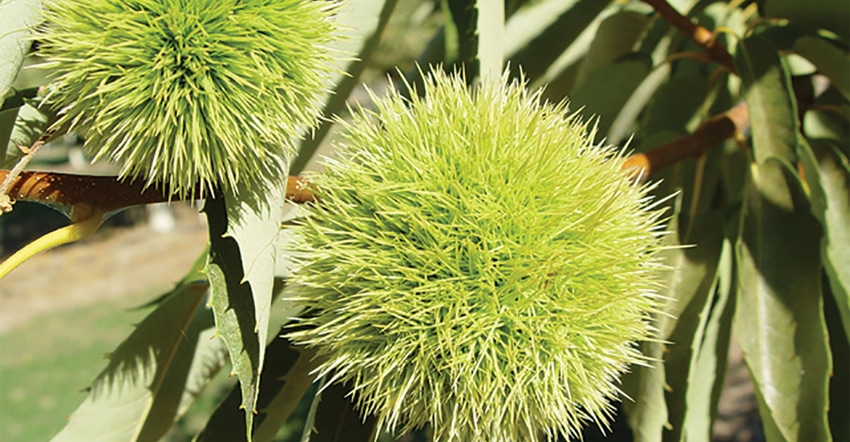
It’s not our intent to plant a musical earworm in your head – “Chestnuts roasting on an open fire” — but it’s that time of year again.
While chestnuts are the No. 3 nut on a worldwide scale, in the U.S, they represent a niche market. As one grower explained it, chestnuts are to the nut world what soccer is to the sports world — popular everywhere else except in the United States.
They do start to receive increased stardom at this time of the year because while they can still be roasted on open fires, they can also be boiled and sautéed like a vegetable, pureed like potatoes, ground into flour, or because of their meaty texture and slightly sweet flavor, eaten raw.
Chestnut trees grow well in the Pacific Northwest, principally Oregon’s Willamette Valley and in Washington, requiring a relatively low initial investment to enter the marketplace — but needing patience as new plantations take a few years to reach a break-even point.
What is possibly the largest recorded American chestnut tree still grows in Sherwood, Ore., boasting a trunk some six feet in diameter, holding true to its original designation as “the redwood of the East.”
There are some key ingredients to growing success, like soil. Chestnut trees require well-drained soil on the acidic side of the pH scale. They respond best to a minimum of 100 frost-free days and at least six hours of full sun daily. And pests of the four-legged kind (deer) and of the hopper variety (rabbits) love to destroy the younger trees. Given some periodic TLC, they can live a thousand years.
“This year’s nut quality is very good with some very large chestnuts due to the amount of rain we received through much of the summer,” said Bernie Hilgart, operations manager of the Washington Chestnut Company’s 21-acre farm in Everson. “We expect production to be up 30% from last year as a result of better orchard management.”
Sweeter chestnuts
The company web page notes: “Northwest Washington state grows sweeter chestnuts because of a cool growing season that allows trees to hold onto the nuts longer than in warmer growing areas.” The later the nuts fall, the more freshness is ensured because the nuts spends less time in cold storage.
In their Chestnut News publication, Washington Chestnut Company notes that while their nursery operation offers over 30 cultivars, they are part of several organizations evaluating a cultivar known as Szego.
“It has many traits supporting the needs of commercial growers east of the Rocky Mountains like easy growing, excellent nut set, good flavor and texture, and resistance to chestnut blight and phytophthora.”
The company that began some 30 years ago planting butternuts and English-style walnuts also suggests that drought-tolerant chestnut trees grow into beautiful shade trees that produce a great tasting nut requiring no picking. It self-harvests as Mother Nature causes the nuts to drop to the ground in the Fall.
Nella Chestnut Farm in Hood River, Ore., grows the colossal variety of chestnuts, a Japanese-European grafted hybrid developed for superior size, sweetness, and ease of peeling. The nuts themselves are about 2-3 inches in diameter with about two dozen to a pound.
Owner Bernardo Nello said, “This was a good year, more nuts and bigger nuts.” He is caretaker to some 250 trees on 10 acres and allows U-Pick visitors during the height of nut drop. After that, he buries chestnuts in the sand to keep them fresh for Christmas season sales. Remaining leftover chestnuts are placed in aerated bins where they sprout roots to become baby trees.
Those baby trees are delicate when first planted and need to be protected from marauding deer out to destroy them, but once they become sturdy, they require only a bit of trimming before producing — from grafted stock, about two to three years, from seed, about four to five.
Nearby, on 17-acres in McMinnville, is RC Farms run by Randy and Irene Coleman. They tell customers that chestnuts can be roasted, broiled, boiled, steamed, microwaved, or vacuum-sealed in bags and stored in the freezer for up to a year. They recommend: “Select nuts that are plump, heavy, firm to the touch with unshriveled, unscarred, uncracked shells that are shiny brown.”
For more news on tree nuts as reported by growers and farm advisors, subscribe to the Tree Nut Farm Press e-newsletter.
Read more about:
Chestnut TreesAbout the Author(s)
You May Also Like




